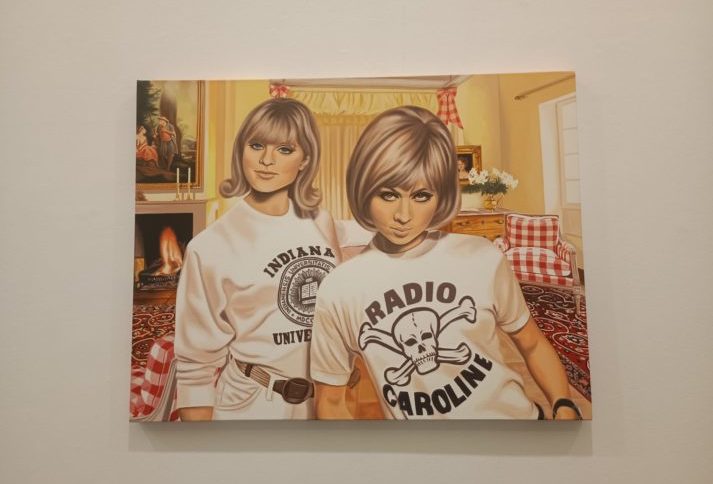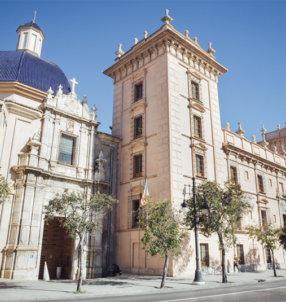24/7 VALENCIA: Could you tell us more about this ‘Cuqui Guillén’ exhibition at ‘Sala Parpallo’ at MuVIM?
Curator of the exhibition Johanna Caplliure: “Cuqui Guillén is one of the most relevant artists of what was known as neokitsch or Valencian pop in the 90s. For this exhibition at the MuVIM, a sample of her work has been selected in which her most recent and unpublished works can be seen, combined with some earlier ones. Although this exhibition is constructed under a chronological thread between different pieces, it is not a retrospective, but a perspectival exhibition whose direction aims to understand in Guillén’s work the subversive forms that, from suggestion, enjoyment, memory and fetishism, can be created after pop. In such a way that this proposal will give us the opportunity to enter, through a novel journey, into the colourful, explosive, enigmatic and ideological universe of the author, suggesting a creative commitment that survives to the present day. Thus, the exhibition ‘A subversive temptation’ aims to be understood as an unprecedented re-reading of Cuqui Guillén’s work.
Since the 1980s, Cuqui Guillén (València, 1967) has been developing her career as an artist continuously, either as a collective, together with Cari (Carmen Roig) as part of the Límite team, or individually over the last three decades. Her work conjures up a series of primordial myths inscribed in modern art which, accelerated by the hyper-consumption of the pop gaze and globalisation in the late 20th century, alter the meanings of the original icons. In this way, three theoretical concepts offer us the possibility of constructing a reflexive and historicist reading of her work, which, moreover, will weave the exhibition’s plot. These are: performative contradiction, controversy and camp.
There is a rhythm in Cuqui Guillén’s painted scenes that exerts its force voluntarily against the current. A narrative montage that struggles between weak and powerful images to compose a rhythm of its own. Jessica Morgan defined this form of syncopated narrative under the concept of “performative contradiction”, following Jünger Habermas. This would explain how, by uttering certain statements, the opposite of what could be expressed is being said.
Here, pop media would be used as a subversive and feminist strategy to contradict itself. In such a way that the images would dare to be shown in a polemical way, because the discourses that could be asserted from them would enter into controversy. The use of controversy as a tool for reflection and as a response to the unquestionable knowledge of modernity imposes itself, making uncomfortable those who believed they were lavishing themselves in closed discourses on any question of our culture, and thus destabilises unilateral positions.
If we look at the expression of women’s liberation through the emancipation of their body, desire and sexuality, a recurring theme in the work of our artist, we can see how the controversy has unleashed a series of ambivalent positions within feminism that shake the phallocentric logic or phallogocentrism, that is to say, the ratio of patriarchal hegemony. The use of this type of pictorial narrative is a weapon that counteracts the scoptophilia of the phallogocentric gaze. Thus, this idea of the camp as exaggeration or affectation, as Susan Sontag would argue, would become the act of “seducing in a certain way” or, as determined in Guillén’s work, making a temptation subversive.
In 1964, American critics defined the camp as “the being-as-representation-of-a-role”. An exuberance of representation that promotes an elongation of the meaning of representation. The camp sensibility seemed to bring together seemingly opposing or contradictory issues, tendencies or positions, for when the self is the exaggerated representation of a role, the stretching of the self is such that it can be deformed into its opposite. Thus, pop acquired certain gestures that played with stereotypes, made extravagant appearances of antagonistic beings that were reconciled by the science of pastiche or brought desired situations that lubriciously awakened the mind of the mass consumer. In the case of Cuqui Guillén, we can observe how she recognises herself, albeit from a feminist perspective and a rhetoric of complexity that, as can be seen through the observation of his works, will be the backbone of his latest productions.
Her work has also been repeatedly distinctive of the feminine and even of the maternal and yet her work is still somewhat influenced by feminism and has matriarchal influences too. From these postulates, she detects the folds of the normative and stretches them to place herself in uncomfortable places where she installs subversion in the form of’ joie de vivre’. A joie de vivre that embodies enjoyment. In the joy of life, in the enjoyment of sexuality, in the fullness of sensuality and self-care, in the sweetness of paying homage to her ancestors or in the tenderness of showing a child beginning to speak, there is also struggle. Combat is also resistance. And there is nothing to contradict these Amazon figures who conquer their place in caress and surrender. In fact, it could be said that the guiding thread of the whole exhibition is the ‘joie de vivre’ conjured with the mythologies of postmodernity, its controversies and incoherencies in a globalised world where temptation is articulated under a feminist strategy from artistic practice.
Finally, if we look at what would appear to be a chronological journey, as we pointed out earlier, we have drawn up an itinerary through three of the artist’s most important series in her individual career, placing greater emphasis on the works she has been developing over the last six years. From this last series, some pieces will be shown that will see the light for the first time, beyond the artist’s studio, on the occasion of her exhibition at the MuVIM. Thus, the exhibition includes more than twenty works, including large-format and medium-format paintings and drawings from the series Waiting in Hotels (2017-2022), Give me more (2013-2015) and El Pop de Mami (2008-2012).”
Interview by ‘24/7 Valencia’ team
Article copyright ‘24/7 Valencia’
Photo copyright ‘24/7 Valencia’
Cuqui Guillén
Temporary exhibition 2023
‘Sala Parpallo’
MuVIM
Guillem de Castro, 8
46001
València
Tel: 963 88 37 30
| Monday | Closed |
| Tuesday | 10 AM–2 PM, 4–8 PM |
| Wednesday | 10 AM–2 PM, 4–8 PM |
| Thursday | 10 AM–2 PM, 4–8 PM |
| Friday | 10 AM–2 PM, 4–8 PM |
| Saturday | 10 AM–2 PM, 4–8 PM |
| Sunday | 10 AM–8 PM |
Free entry
Related Post
This site uses Akismet to reduce spam. Learn how your comment data is processed.

























Leave a comment